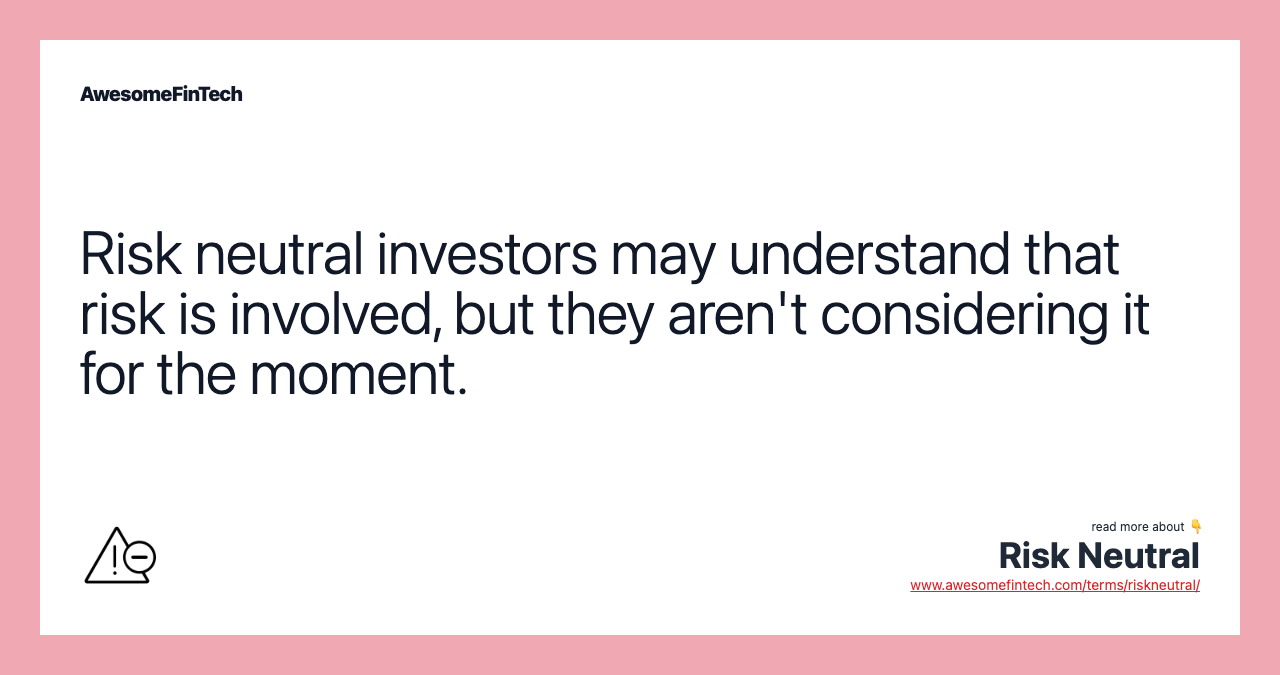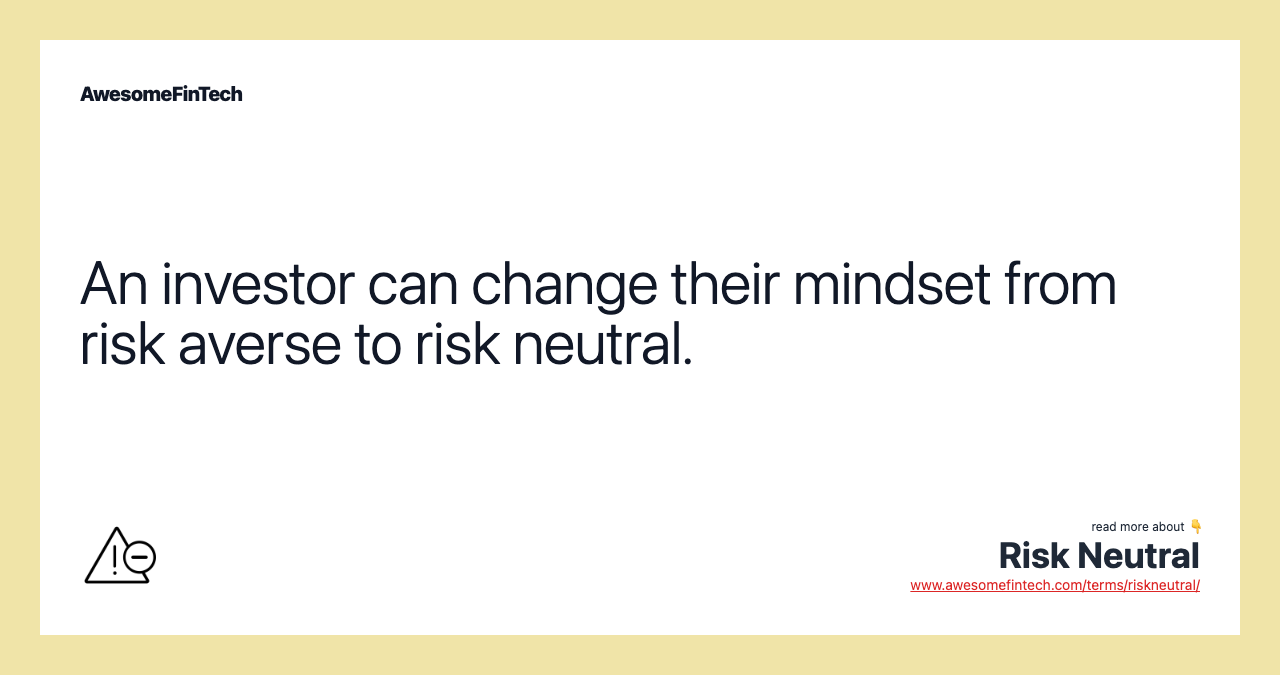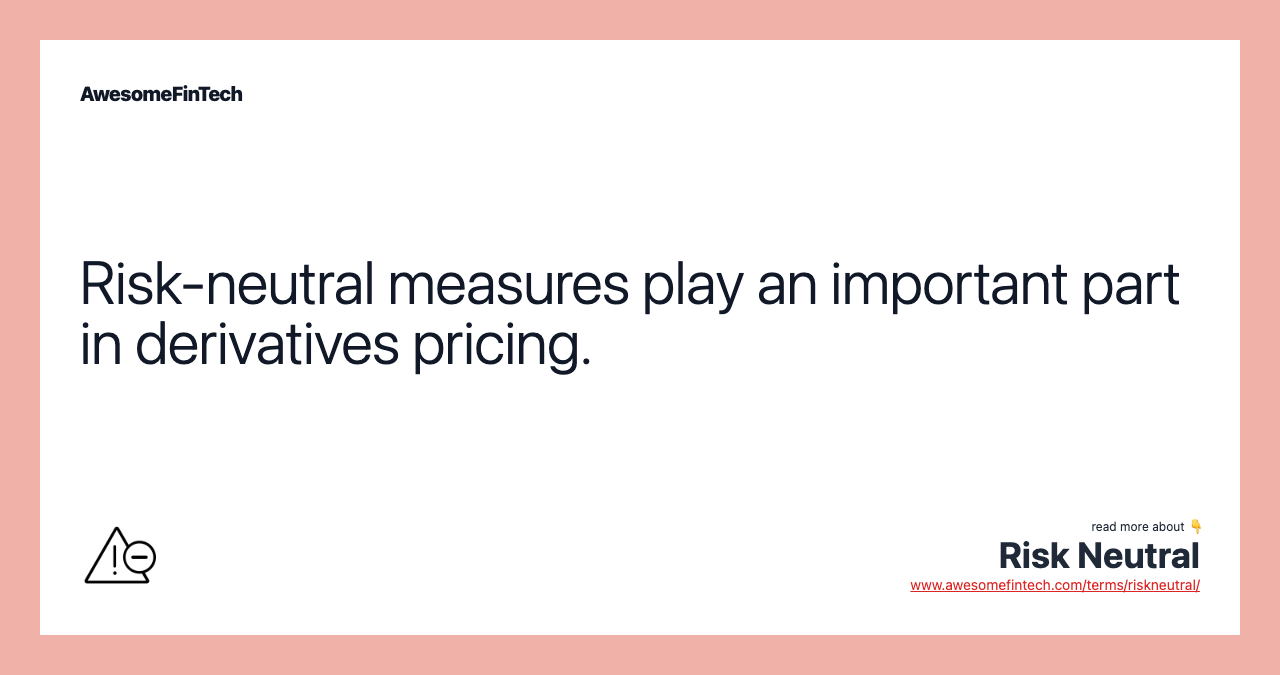Risk Neutral
Risk neutral is a concept used in both game theory studies and in finance. There could be any number of reasons why an individual would reach a risk-neutral mindset, but the idea that an individual could actually change from a risk averse mindset to a risk-neutral mindset based on pricing changes then leads to another important concept: that of risk-neutral measures. If the probability of doubling were to shift to 60%, then those who were willing to consider the alternative at that point, would have adopted a risk-neutral mindset, because they were focused on the probability of gain and no longer focused on the risk. In this scenario, those who responded A, would be considered risk-averse investors, and those who responded C would be considered risk seeking investors, since the investment value is not accurately determinable with only that much information. Risk-neutral measures have extensive application in the pricing of derivatives because the price where investors would be expected to exhibit a risk-neutral attitude should be a price of equilibrium between buyers and sellers.

What is Risk Neutral?
Risk neutral is a concept used in both game theory studies and in finance. It refers to a mindset where an individual is indifferent to risk when making an investment decision. This mindset is not derived from calculation or rational deduction, but rather from an emotional preference. A person with a risk-neutral approach simply doesn't focus on the risk--regardless of whether or not that is an ill-advised thing to do. This mindset is often situational and can be dependent on price or other external factors.




Understanding the Concept of Risk Neutral
Risk neutral is a term used to describe the attitude of an individual who may be evaluating investment alternatives. If the individual focuses solely on potential gains regardless of the risk, they are said to be risk neutral. Such behavior, to evaluate reward without thought to risk, may seem to be inherently risky. A risk averse investor would not consider the choice to risk a $1000 loss with the possibility of making a $50 gain to be the same as risking only $100 to make the same $50 gain. However someone who is risk neutral would. Given two investment opportunities the risk-neutral investor only looks at the potential gains of each investment and ignores the potential downside risk.
Risk Neutral Pricing and Measures
There could be any number of reasons why an individual would reach a risk-neutral mindset, but the idea that an individual could actually change from a risk averse mindset to a risk-neutral mindset based on pricing changes then leads to another important concept: that of risk-neutral measures. Risk-neutral measures have extensive application in the pricing of derivatives because the price where investors would be expected to exhibit a risk-neutral attitude should be a price of equilibrium between buyers and sellers.
Individual investors are almost always risk averse, meaning that they have a mindset where they exhibit more fear over losing money than the amount of eagerness they exhibit over making money. This tendency often results in the price of an asset finding a point of equilibrium somewhat below what might be accounted for by the expected future returns on this asset. When trying to model and adjust for this effect in marketplace pricing, analysts and academics attempt to adjust for this risk aversion by using these theoretical risk-neutral measures.
For example, consider a scenario where 100 investors are presented and accept the opportunity to gain $100 if they deposit $10,000 in a bank for six months. There is virtually no risk of losing money (unless the bank itself were in danger of going out of business). Then suppose those same 100 investors are subsequently presented with an alternative investment. This investment gives them the opportunity of gaining $10,000, while accepting the possibility of losing all $10,000. Finally suppose we poll the investors over which investment they would choose and give them three responses: (A) I'd never consider that alternative, (B) I need more information about the alternative investment, (C) I'll invest in the alternative right now.
In this scenario, those who responded A, would be considered risk-averse investors, and those who responded C would be considered risk seeking investors, since the investment value is not accurately determinable with only that much information. However, those who responded with B recognize that they need more information to determine whether they would be interested in the alternative. They are neither adverse to risk nor seeking it for its own sake. Instead, they are interested in the value of expected returns to know whether or not they prefer to take the risk. So at the moment they seek more information, they are considered risk neutral.
Such investors would probably want to know what the probability of doubling their money might be (in comparison to possibly losing it all). If the probability of doubling were only 50%, then they could recognize that the expected value of that investment is zero since it has an equal possibility of losing everything or doubling. If the probability of doubling were to shift to 60%, then those who were willing to consider the alternative at that point, would have adopted a risk-neutral mindset, because they were focused on the probability of gain and no longer focused on the risk.
The price at which risk-neutral investors manifest their behavior of considering alternatives, despite the risk, is an important point of price equilibrium. This is a point where the greatest number of buyers and sellers may be present in the market.
Related terms:
Derivative
A derivative is a securitized contract whose value is dependent upon one or more underlying assets. Its price is determined by fluctuations in that asset. read more
Expected Utility
Expected utility is an economic term summarizing the utility that an entity or aggregate economy is expected to reach under any number of circumstances. read more
Loss Aversion
Loss aversion in psychology refers to the emotional side of investing, namely the negative sentiment associated with recognizing a loss and its psychological effects. read more
Risk-Neutral Measures
A risk neutral measure is a theoretical measure of a market's risk aversion. read more
Risk-Neutral Probabilities
Risk-neutral probabilities are the odds of future outcomes adjusted for risk, which are then used to compute expected asset values. read more
Risk Averse
The term risk-averse describes the investor who prioritizes the preservation of capital over the potential for a high return. read more
Risk Lover
A risk lover is an investor who is willing to take on additional risk for a comparatively low additional expected return in exchange for that risk. read more